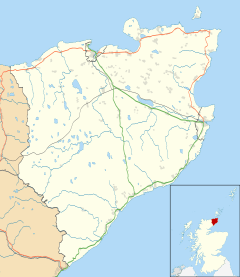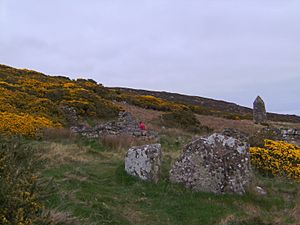Badbea facts for kids
Quick facts for kids Badbea |
|
|---|---|
 A view of Badbea |
|
| OS grid reference | ND086196 |
| Council area | |
| Lieutenancy area | |
| Country | Scotland |
| Sovereign state | United Kingdom |
| Police | Northern |
| Fire | Highlands and Islands |
| Ambulance | Scottish |
| EU Parliament | Scotland |
Badbea (pronounced bad-bay) is a former village in Scotland. It sits on steep slopes above cliffs on the east coast of Caithness. This village was created during the Highland Clearances. This was a time when many families were forced to leave their homes.
Badbea is about 5 miles (8 km) north of Helmsdale. Families moved here in the 1700s and 1800s. They had been evicted from their homes in nearby valleys like Langwell and Berriedale. Their old homes were cleared to make way for sheep farms. The last person left Badbea in 1911. Later, a monument was built there. It was put up by the son of Alexander Robert Sutherland, who had moved to New Zealand. Today, the village ruins are a place for visitors. They serve as a reminder of the Highland Clearances.
Contents
What is Badbea Like?
Badbea can be reached by a path from the A9 road. The old houses are now just ruins. You can still see some stone walls. The shapes of the buildings and old farm fields are also visible. Signs along the path and in the village tell visitors about the people who lived there. They also share the history of this special place.
A Look at Badbea's History
In the late 1700s, many tenant farmers in the Scottish Highlands were forced to leave. Landowners wanted to use the land for sheep farming instead. From 1792, families began to arrive in Badbea. This was a small, rough area of land. It was squeezed between high stone walls for sheep and the cliffs above the North Sea.
Many families came from nearby Ousdale. The landowner, Sir John Sinclair, had moved them to raise sheep. Other families came from villages like Auchencraig and Kildonan. When the families arrived, they got small plots of land. They had to clear the land themselves. They also built their homes from stones they found. By 1814, there were 80 people living in Badbea.
Later, the main job in Badbea was herring fishing. But in the late 1800s, the landowner changed things. He preferred salmon fishing. Because of this, many families left Badbea. They moved away to find better lives. One person, Alexander Sutherland, had already moved to New Zealand in 1838.
Daily Life in Badbea
The small plots of land were called crofts. Each croft had space for a longhouse. This house had a byre (a cow shed) at one end. There were also other small buildings. Each family had a kitchen garden, called a kailyard. The rest of the land could only support small vegetable patches. Families also kept a few cows, pigs, and chickens. Fresh water came from a nearby spring.
The village only had one horse. There was no plough to prepare the soil. So, people used a chaib, which was a special kind of spade. A man would pull the harrow himself to break up the soil. Every house had a spinning wheel. All the women learned to spin and card wool.
The men mostly worked as herring fishermen from nearby Berriedale. The women cleaned the fish that were caught. Life was tough, especially with strong winds. To keep children and animals safe, they were sometimes tied to rocks or posts. This stopped them from being blown over the cliffs or into the sea. When herring fishing was good, there was plenty of food. But fishing was dangerous, especially for men who were used to working on land.
John Sutherland, The Preacher
John Sutherland (1789-1864) was an important person in Badbea. He was a leader, a preacher, and even acted as a doctor. People said he owned the only watch in the village. John was born in Ousdale before the clearances. He had a brother who died in the Battle of Waterloo. John never married because he had to care for his sisters after his father died young.
The nearest church was far away. So, John, who was a very religious man, opened his home on Sundays. He preached to anyone who came. John was a great speaker. He became known as "John Badbea." He was one of the most famous preachers in the Caithness Church of Scotland. These preachers were known as "The Men" of Caithness. John did many duties for the church. He made many friends across Caithness and Sutherland.
In 1855, when he was 66, John wrote a letter to a friend. He asked about another friend who had moved to New Zealand. He wrote: "...This is a weary and dreary wilderness. 'The mirth of the land is gone'. Everything is out of order..." John Sutherland died at age 75. Many hundreds of people came to his funeral in Berriedale. They had traveled long distances to show their respect.
The Badbea Monument
The last person left Badbea in 1911. In that same year, a monument was built. It was made from stones from John Sutherland's old home. David Sutherland, the son of Alexander Robert Sutherland (who moved to New Zealand), put up the monument. It was built to remember his father and all the people of Badbea.
Images for kids









